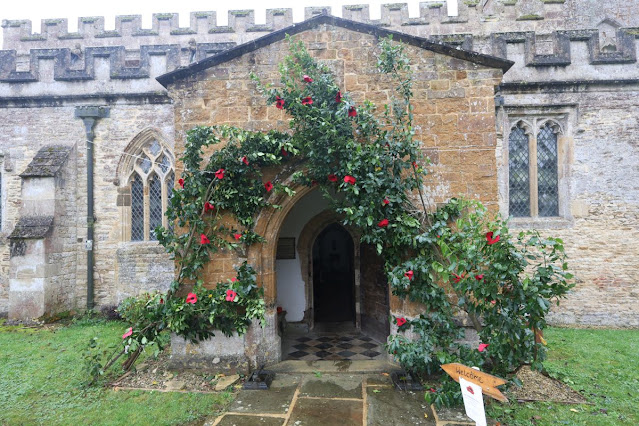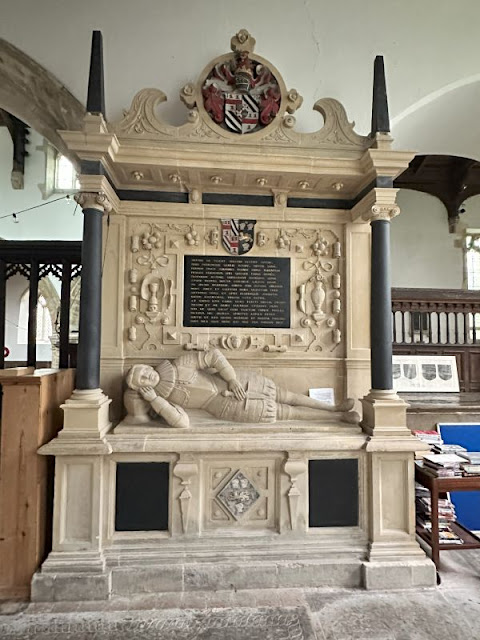This week the Church Explorer travels further north in Oxfordshire to visit St James the Apostle Somerton one of Oxfordshires Best Churches I am visit from the book, I managed to visit three other churches after this one as well making the most of my time in the area.
The Church of England parish church of Saint James the Apostle is known to have existed by 1074. A Norman carved doorway in the nave dates from this period. Much of the building, however, including the bell tower, is Decorated Gothic from the first half of the 14th century. St. James' also has features from the 13th, 15th and 16th centuries. St. James' is a Grade I listed building.
The tower has a ring of eight bells. Henry I Bagley of Chacombe, Northamptonshire cast the tenor and seventh bells in 1635. One of these bells was paid for by John and Isabel Aston. Henry I Bagley cast also the fourth bell in 1646 and the fifth bell in 1670. His descendant Henry III Bagley cast the sixth bell in 1707, completing the set of five bells noted in The Gentleman's Magazine in 1827. John Taylor & Co of Loughborough cast the third bell (which then would have been the treble) in 1896, making a ring of six. In 1974 the Whitechapel Bell Foundry added the present treble and second bells, increasing the ring to eight. At the same time all eight bells were also rehung. St. James' parish is now part of the Cherwell Valley Benefice along with five other parishes: Ardley, Fritwell, Lower Heyford, Souldern and Upper Heyford.
South side view
East end view with south aisle
Tall north window
I think this is the west doorway
View from the north east
Roof line view
Tower top
The gargoyles around the tower
Cropped view of the rood
The medieval preaching cross near the church
Headstones near the east boundary
These older ones are near the porch
Various churchyard scenes
The inscription on this tomb can be read, I did not check to see what it said
Graves of varying ages
Tomb among the headstones
More older headstones
This is the cemetery extension on the south of the church looking east
Looking west
Older headstones on the north of the church
Further on a few more long forgotten
The porch decorated for remembrance day
Doorway in the porch
North aisle as you come in
The nave from the back
Wide view of the nave and aisles
Rood screen which is mostly restored with out the rood loft
Inside the chancel
Altar and east window
The altar
Behind which is this superb reredos of the last supper
I moved the altar cross out of the way to get a photo of the reredos
The east window
Rear view of the rood screen
Looking out to the back of the church
Pulpit
Looking down from the pulpit
The box pews in the north aisle
The altar with east window
Which again is quite superb
The rolls of honour can be seen in the north aisle
With both wars shown
The memorial on an arch dates to 1665
Collage of memorials, there are more in the church
Not sure of the age of the clock mechanism it did not say
This is the Fermor chapel
With some wonderful tomb effigies
Showing members of the Fermor family
With inscriptions above the figure
The ones opposite each other look new
And just show a male figure in armor
Latin inscription
This one is older showing Thomas Fermor and his wife
The detail on the wife's dress is amazing and still has paint on it
This chest tomb is older with brasses on the top
Ready made collage of memorials and funerary hatchments
and a third funerary hatchment between the arches
Collage of other items of interest in the church, I thought the top left one was a flail when I saw it but it is the old key to the church
Old memorial, I could not give a date to it
Fermor memorial
This picture puzzled me because it shows the execution of King Charles I






































































8 comments:
I found the effigies fascinating, Billy, particularly as they were in such good shape. This is, indeed, a lovely church. Have a blessed week!
What a wonderful church and there are some superb monuments in there. I do like the East Window. Have a good week.
That’s an impressive church! Eight bells… Do they still play them?
I love the little stone men sitting at the table! Very cute. #Mysundaysnapshot
Tahnk you for this detailed tour of the church. I love seeing the gravestones too.
Wow... what a historical building this Church.
Another wonderful contribution for MosaicMonday. Thank you so much for your participation, dear blog friend. ...very interesting to read!
There is so much to discover each time and I like to read through the posts at my leisure to appreciate the pictures and text. It is a varied journey, full of surprises and lots of history.
Greetings from Heidrun
Fascinating to see a church that blends architectural styles from several different eras!
Thanks for sharing at https://image-in-ing.blogspot.com/2024/11/bushmills-distillery.html
Such a stunning building! Thanks for sharing and for taking part in #MySundaySnapshot.
Post a Comment